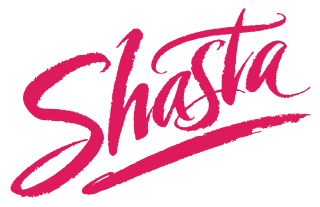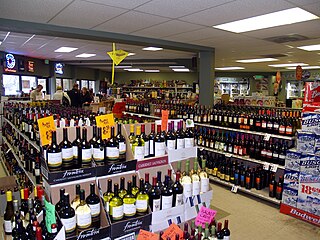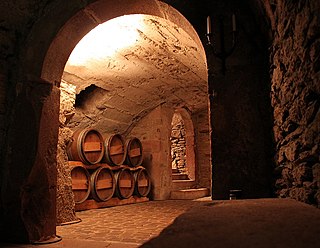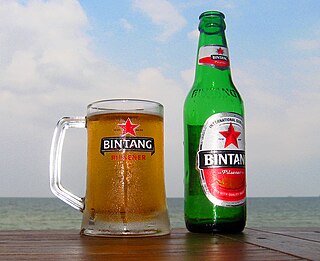
Low-alcohol beer is beer with little or no alcohol by volume that aims to reproduce the taste of beer while eliminating or reducing the inebriating effect, carbohydrates, and calories of regular alcoholic brews. Low-alcohol beers can come in different beer styles such as lagers, stouts, and ales. Low-alcohol beer is also known as light beer, non-alcoholic beer, small beer, small ale, or near-beer.

A convenience store, convenience shop, bodega, corner store, corner shop, or superette is a small retail store that stocks a range of everyday items such as convenience food, groceries, beverages, tobacco products, lottery tickets, over-the-counter drugs, toiletries, newspapers and magazines.
A no-frills or no frills service or product is one for which the non-essential features have been removed to keep the price low. The term "frills" originally refers to a style of fabric decoration. Something offered to customers for no additional charge may be designated as a "frill" – for example, free drinks on airline journeys, or a radio installed in a rental car. No-frills businesses operate on the principle that by removing luxurious additions, customers may be offered lower prices.

Shasta Beverages is an American soft drink manufacturer that markets a value-priced soft drink line with a wide variety of soda flavors, as well as a few drink mixers, under the brand name Shasta. The company name is derived from Mount Shasta in northern California and the associated Shasta Springs.

A liquor store is a retail business that predominantly sells prepackaged alcoholic beverages, including liquors, wine or beer, usually intended to be consumed off the store's premises. Depending on region and local idiom, they may also be called an off-licence, off-sale, bottle shop, bottle store or, colloquially, bottle-o, liquor store or other similar terms. A very limited number of jurisdictions have an alcohol monopoly. In US states that are alcoholic beverage control (ABC) states, the term ABC store may be used.

Disney's Pop Century Resort is a resort located at the Walt Disney World Resort in Lake Buena Vista, Florida, opened on December 14, 2003. It is the fourth value-priced resort in the complex, following Disney's All-Star Movies, All-Star Music, and All-Star Sports Resorts in the 1990s. The resort is themed around 20th century American pop culture.
In catering, beverage functions are functions where beverages are served.

Chūhai, an abbreviation of "shōchū highball" (焼酎ハイボール), is an alcoholic drink originating from Japan.

A liquor license is a governmentally issued permit for businesses to sell, manufacture, store, or otherwise use alcoholic beverages.

Anju is a Korean term for food consumed with alcohol. It consists of a variety of foods, including both main dishes and side dishes. Consuming food with alcohol is a widespread practice in Korea, especially when the alcoholic beverage soju is involved.

Alcoholic drinks in Sweden are as common as in most of the Western world. Sweden is historically part of the vodka belt, with high consumption of distilled drinks and binge drinking, but during the later half of the 20th century, habits became more harmonized with western Europe, with increasing popularity of wine and weekday drinking. Wine is now also grown and produced in several parts of Sweden and the southernmost region of Skåne is turning into a hub experiencing a strong growth in number of active vineyards.

Hong Kong Hilton was a hotel in Central, Hong Kong. Built in 1963, the 26-storey hotel was initially the only 5-star hotel on the island side of the territory. It closed in May 1995, and was demolished soon thereafter along with Beaconsfield House and carpark to make way for a commercial development, the Cheung Kong Centre.

A kitchenette is a small cooking area, which usually has a refrigerator and a microwave oven, but may have other appliances - for example a sink. They are found in studio apartments, some motel and hotel rooms, college dormitories, office buildings, furnished basements, or bedrooms in shared houses. New York City's building code defines a kitchenette as a kitchen of less than 7.4 m2 (80 ft2) of floor space.

The alcohol laws of Pennsylvania contain many peculiarities not found in other states, and are considered some of the strictest regulations in the United States.

The Tokyo DisneySea Hotel MiraCosta was the second hotel built at Tokyo Disney Resort in Urayasu, Chiba, Japan. It opened on September 4, 2001, alongside the opening of the Tokyo DisneySea theme park. It was constructed under a license by The Walt Disney Company. The hotel is managed by The Oriental Land Company.

A drinking establishment is a business whose primary function is the serving of alcoholic beverages for consumption on the premises. Some establishments may also serve food, or have entertainment, but their main purpose is to serve alcoholic beverages. There are different types of drinking establishment ranging from seedy bars or nightclubs, sometimes termed "dive bars", to 5,000 seat beer halls and elegant places of entertainment for the elite. A public house, informally known as a "pub", is an establishment licensed to serve alcoholic drinks for consumption on the premises in countries and regions of British influence. Although the terms are increasingly used to refer to the same thing, there is a difference between pubs, bars, inns, taverns and lounges where alcohol is served commercially. A tavern or pot-house is, loosely, a place of business where people gather to drink alcoholic beverages and, more than likely, also be served food, though not licensed to put up guests. The word derives from the Latin taberna and the Greek ταβέρνα/taverna.

A buttery was originally a large cellar room under a monastery, in which food and drink were stored for the provisioning of strangers and passing guests. Nathan Bailey's An Universal Etymological English Dictionary gives "CELLARIST – one who keeps a Cella, or Buttery; the Butler in a religious House or Monastery." As the definition in John Stevens's The History of the Antient Abbeys shows, its initial function was to feed and water the guests rather than monks: "The Buttery; the Lodging for Guests". In a monastery a buttery was thus the place from which travellers would seek 'doles' of bread and weak ale, given at the exterior buttery door. The task of doling out this free food and drink would be the role of the butterer. At larger monasteries there would also be a basic hostelry, where travellers could sleep for free.
A hotel amenity is a desirable or useful feature provided when renting a room at a hotel, motel, or other place of lodging. The amenities provided in each hotel vary. In some places of lodging, certain amenities may be standard with all rooms. In others, they may be optional for an additional cost.

Alcohol in Indonesia refers to the alcohol industry, alcohol consumption and laws related to alcohol in the South East Asian country of Indonesia. Indonesia is a Muslim majority country, yet it is also a pluralist, democratic and secular nation. These social and demographic conditions led to Islamic parties and pressure groups pushing the government to restrict alcohol consumption and trade, while the government carefully considers the rights of non-Muslims and consenting adults to consume alcohol, and estimates the possible alcohol ban effects on Indonesian tourism and the economy.

North Korean cuisine is the traditional culinary practices and dishes of North Korea. Its foundations are laid by the agricultural and nomadic traditions in southern Manchuria and the Korean Peninsula. Some dishes are shared by the two Koreas; however, availability and quality of Northern cuisine is much more significantly affected by sociopolitical class divides.

















